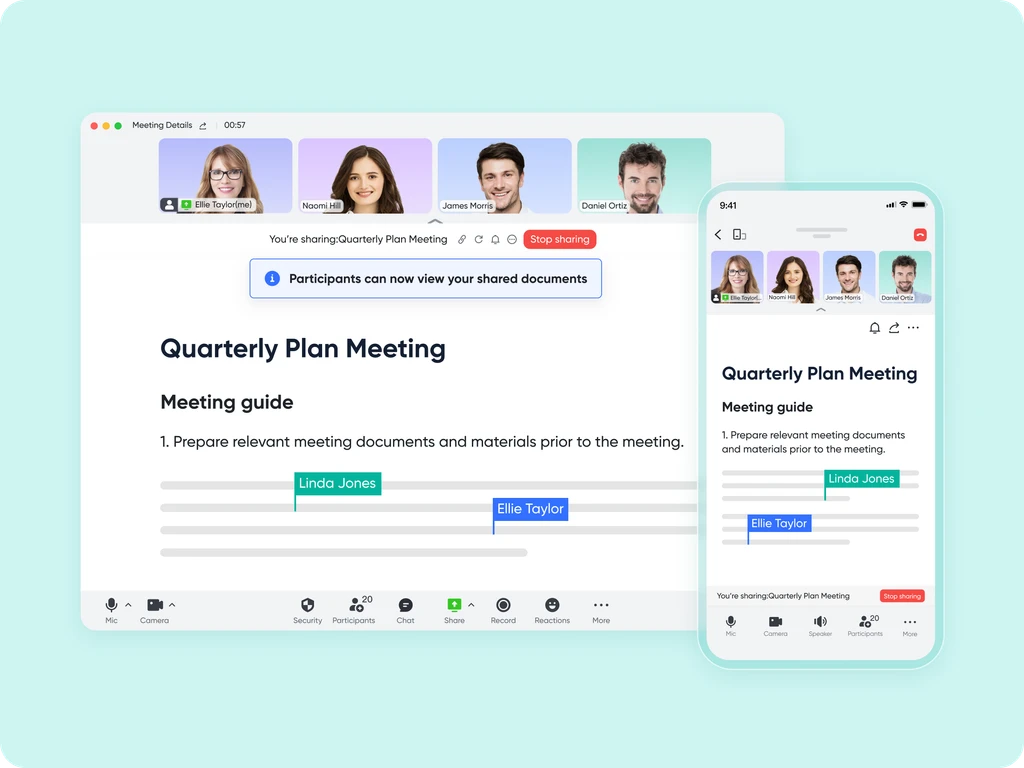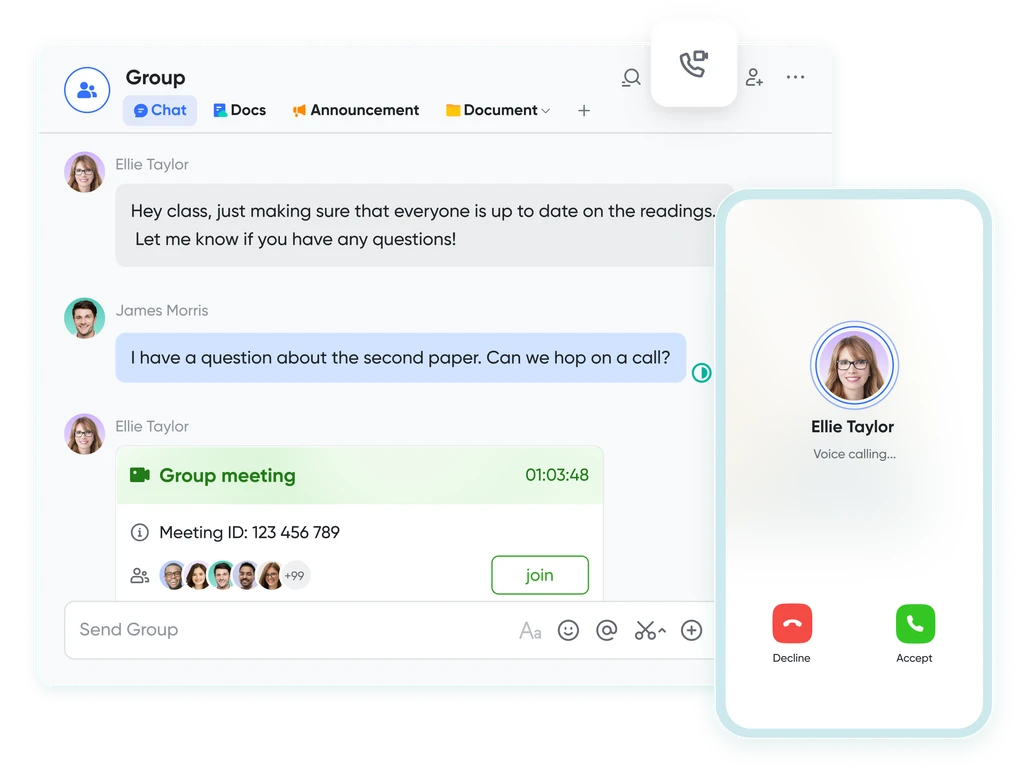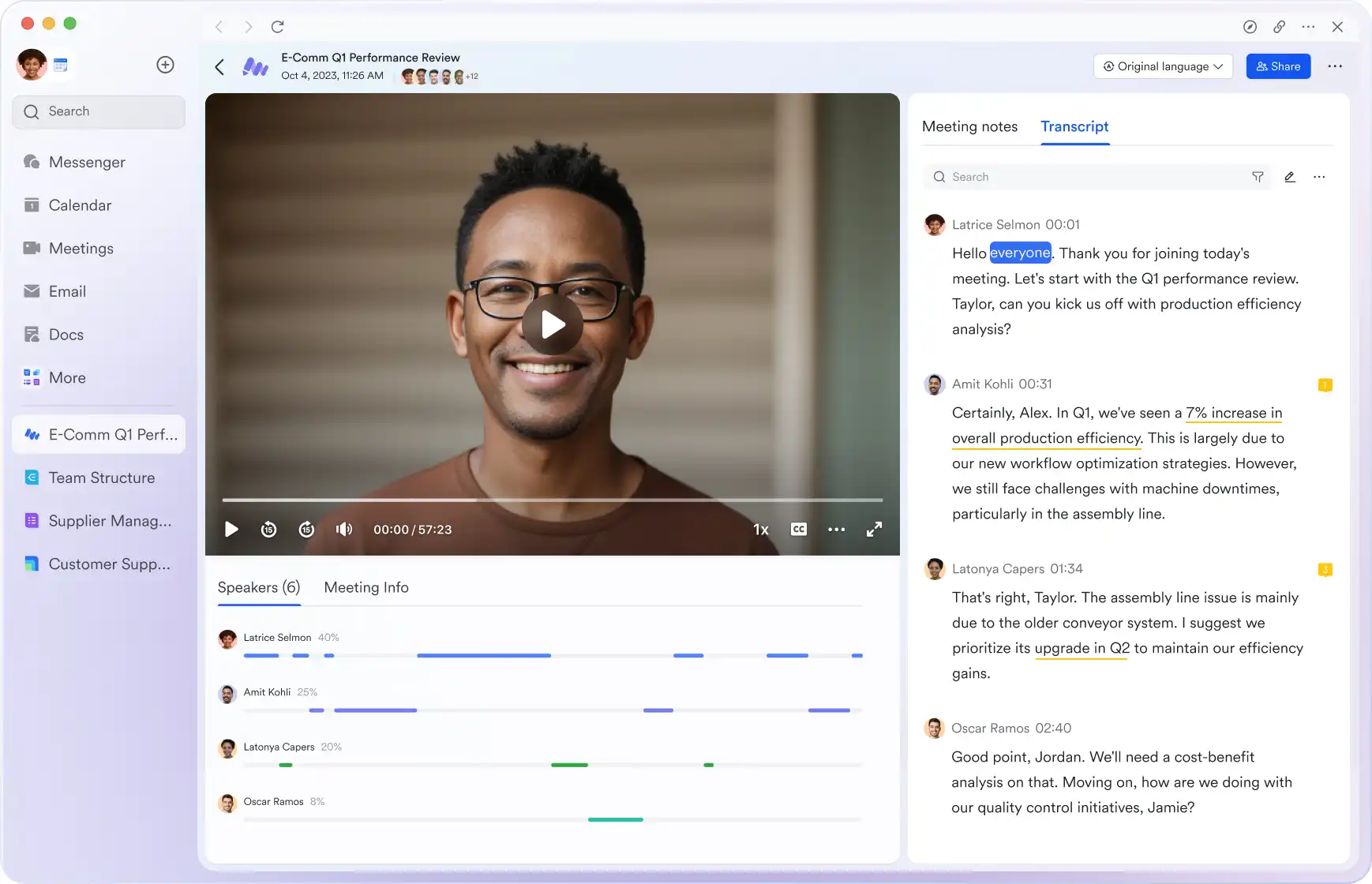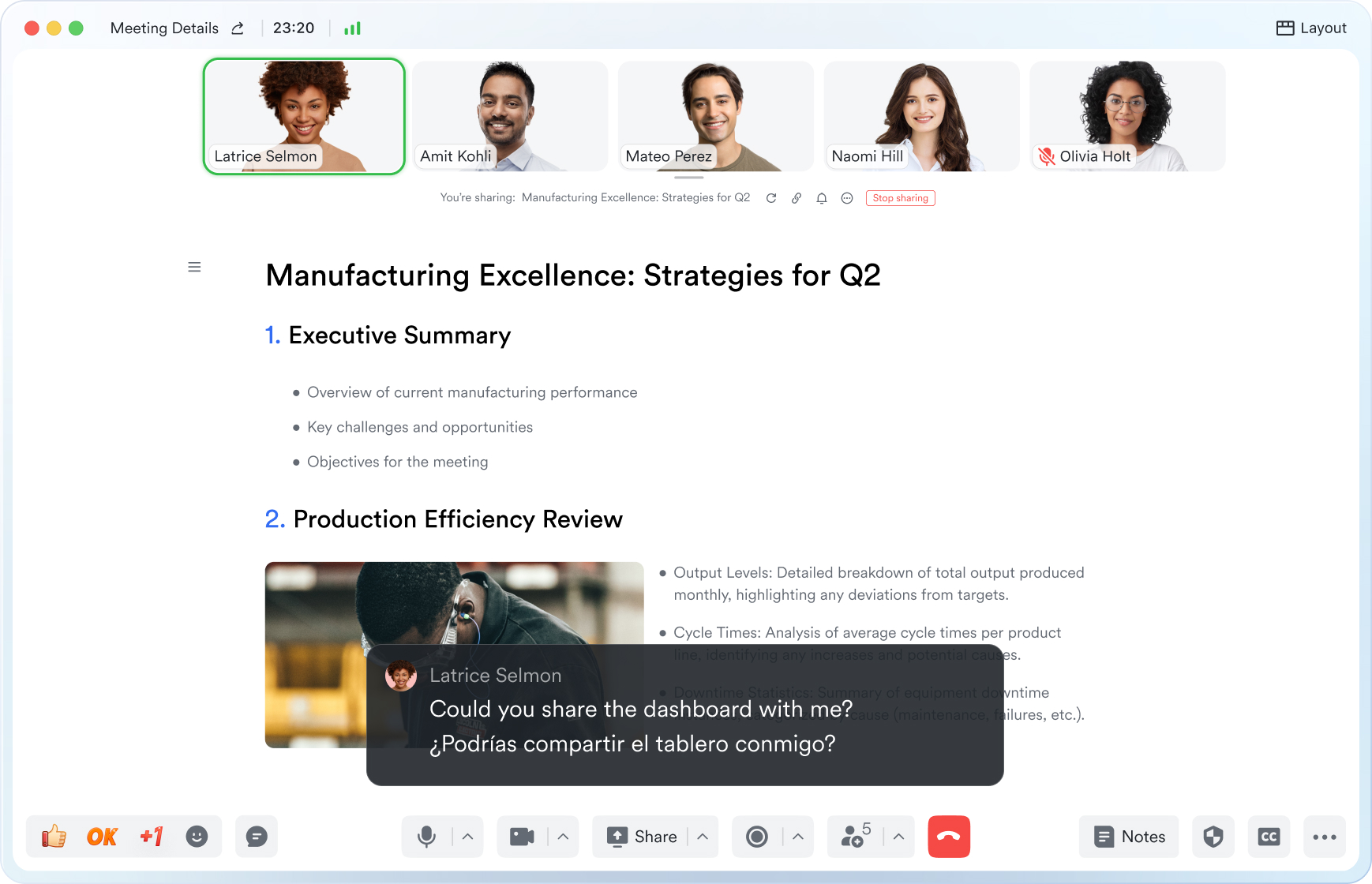Management Meeting
This guide will walk you through the essential elements of use management meeting to keep your attendees aligned and engaged.
Try Lark for Free
In the world of business, effective management meetings are instrumental in aligning leadership, making critical decisions, and driving the organization forward. As a manager or leader, knowing how to conduct a successful management meeting is essential for achieving strategic objectives. In this guide, we'll explore the key elements of a productive management meeting and provide you with practical tips to enhance your leadership meetings.
Use Lark Meetings to turn meetings into true collaborative experiences.
What is a management meeting?
Understanding Management Meetings
A management meeting is a scheduled gathering of key leaders within an organization, such as executives, department heads, or team leaders, to discuss strategic matters, set priorities, make decisions, and align on organizational goals. These meetings are essential for high-level coordination and decision-making.
Goals of a management meeting
Strategic Alignment and Decision-Making
The primary goals of a management meeting include:
- Strategic Alignment: Ensuring that all leaders are aligned with the organization's strategic direction.
- Decision-Making: Making critical decisions that impact the organization's future.
Who should attend a management meeting?
Key Participants
For a successful management meeting, consider involving:
- Top Executives: Including the CEO, President, or other high-level executives.
- Department Heads: Leaders responsible for various functional areas.
- Team Leaders: Leaders responsible for specific teams or projects.
- Stakeholders: Depending on the agenda, stakeholders with a vested interest in certain topics may be invited.
Related:
Unlock the Power of Webinars: A Comprehensive Guide to Boost Your Business | Lark Blog | Lark BlogLearn more about Lark x Meetings
Topics, agenda, and structure of a management meeting
Structuring the Meeting
A well-structured management meeting typically includes the following key components:
- Welcome and Introduction: Opening remarks to set the tone and objectives.
- Review of Previous Meeting Minutes: Discussing action items and progress from the previous meeting.
- Agenda Items: Addressing each agenda item, allowing for in-depth discussions.
- Decision-Making: Making strategic decisions and assigning responsibilities.
- Strategic Updates: Sharing updates on critical projects, initiatives, and performance metrics.
- Future Planning: Discussing future goals, priorities, and strategic directions.
- Action Item Follow-Up: Documenting action items, owners, and deadlines.
- Closing Remarks: Summarizing key takeaways and expressing appreciation.
How to host a management meeting?
Step-by-Step Guide
Hosting a productive management meeting requires careful planning and execution. Follow these steps for an effective leadership gathering:
- Preparation: Create a detailed agenda and share it with participants well in advance.
- Communication: Clearly communicate the purpose and objectives of the meeting.
- Engagement: Encourage active participation and open dialogue among leaders.
- Time Management: Keep the meeting on schedule to respect leaders' time.
- Decision Facilitation: Ensure that critical decisions are thoroughly discussed and documented.
- Follow-Up: Promptly share meeting minutes and action items to drive accountability.
Learn more about Lark x Meetings
How often does a management meeting occur?
Meeting Frequency
The frequency of management meetings can vary based on organizational needs:
- Weekly: Common for organizations requiring frequent strategic adjustments.
- Bi-weekly or Monthly: Suitable for organizations with moderate-level strategic planning.
- Quarterly: Occasional meetings for high-level strategic reviews and planning.
Key differences between management meetings and similar meetings
Understanding Distinctions
Management meetings have unique characteristics that distinguish them from other types of gatherings:
- High-Level Focus: Management meetings deal with strategic, organizational-level matters.
- Leadership Attendance: Participation is typically limited to top leaders.
- Decision-Making Authority: These meetings involve critical decision-making and strategic planning.
Learn more about Lark x Meetings
Common pitfalls of management meetings
Avoiding Mistakes
To ensure the success of your management meetings, avoid these common pitfalls:
- Lack of Clarity: Ensure that meeting objectives and agendas are clearly defined.
- Overloading the Agenda: Keep the agenda focused on strategic priorities.
- Ineffective Decision-Making: Encourage open debate but avoid indecision.
Factors for a successful virtual management meeting
Navigating Virtual Leadership
In an era of remote work, virtual management meetings have become commonplace. Consider these factors for hosting successful virtual management meetings:
- Technology: Use reliable video conferencing and collaboration tools.
- Engagement: Implement interactive elements to keep remote leaders engaged.
- Documentation: Share digital meeting materials and minutes promptly.
Related:
Master the Art of Meeting Notes with Lark for Enhanced Collaboration | Lark Blog | Lark BlogLearn more about Lark x Meetings
Typical takeaways from a management meeting
Measuring Success
Successful management meetings result in tangible takeaways:
- Strategic Alignment: Leaders leave with a shared understanding of strategic priorities.
- Decisions Made: Critical decisions are reached and documented.
- Action Items Assigned: Responsibilities and deadlines are clarified.
Questions to ask in a management meeting
Fostering Meaningful Discussions
To drive meaningful discussions during a management meeting, consider asking these questions:
- **What are the key strategic priorities that require our attention?
- **Are there any obstacles or challenges impacting our strategic goals?
- **What decisions need to be made to advance our strategic objectives?
- **What updates do leaders have on critical projects or initiatives?
- **How can we ensure alignment and collaboration among departments?
Learn more about Lark x Meetings
Tools to enhance management meetings
Leveraging Collaborative Tools
Consider incorporating collaborative tools to enhance your management meetings:
- Scheduling Tools: Use scheduling apps to coordinate leadership meeting times.
- Video Conferencing: Host virtual management meetings to accommodate remote leaders.
- Document Sharing: Share strategic documents and presentations within a secure online platform.
Examples
Real-world scenarios
Real-world scenarios
Let's explore three real-world scenarios of successful management meetings in various contexts:
Scenario 1: Technology Company Management Meeting
Brief Content: In a management meeting at a technology company, top executives discussed market trends, product development strategies, and revenue goals. The meeting facilitated alignment among leaders and resulted in strategic decisions for product expansion.
Detailed Content: The meeting commenced with a review of industry trends and competitive analysis. Leaders shared insights on product development, including innovative features and market positioning. Strategic decisions were made to expand product offerings, with clear action items assigned to various departments. The meeting concluded with a renewed commitment to achieving revenue targets.
Scenario 2: Healthcare Organization Management Meeting
Brief Content: A management meeting in a healthcare organization focused on patient care quality, operational efficiency, and staff development. The meeting promoted collaboration among department heads and resulted in a revised patient care improvement plan.
Detailed Content: The meeting began with a discussion of patient care metrics and performance indicators. Department heads shared initiatives aimed at enhancing patient care quality and streamlining operations. Leaders collaboratively revised the patient care improvement plan, with specific responsibilities assigned to each department. The meeting ended with a renewed focus on patient-centric care.
Scenario 3: Retail Corporation Management Meeting
Brief Content: In a management meeting at a retail corporation, leaders discussed sales performance, inventory management, and expansion strategies. The meeting fostered cross-functional collaboration and led to decisions on opening new store locations.
Detailed Content: The meeting began with an analysis of sales data and inventory levels. Leaders discussed market opportunities and the potential for opening new store locations. Decisions were made regarding the expansion plan, including the selection of target locations and timelines. The meeting concluded with a strategic roadmap for growth.
Learn more about Lark x Meetings
Tips for do's and don'ts
Best Practices and Pitfalls to Avoid
Follow these do's and don'ts to ensure productive and effective management meetings:
| Do's | Don'ts |
|---|---|
| Establish a clear and focused agenda. | Don't allow the meeting to veer off-topic. |
| Encourage open and constructive dialogue. | Avoid micromanaging or dominating discussions. |
| Document decisions and assign action items. | Neglect to follow up on decisions and action items. |
Faqs for management meetings
1. What is the purpose of a management meeting?
- A management meeting serves the purpose of bringing together top-level executives and leaders to discuss strategic matters, make decisions, and align on the direction of the organization.
2. How often should management meetings be held?
- The frequency of management meetings can vary but is typically held on a regular basis, such as monthly or quarterly, to review performance and set strategic objectives.
3. Who usually participates in management meetings?
- Management meetings typically involve senior executives, department heads, and key decision-makers who are responsible for guiding the organization's strategy and operations.
4. What topics are commonly discussed in management meetings?
- Management meetings often cover topics like financial performance, strategic planning, market analysis, resource allocation, and high-level decision-making.
5. How do management meetings contribute to organizational success?
- Management meetings play a crucial role in aligning leadership, setting strategic priorities, and making informed decisions that impact the organization's growth and success.
6. Is there a difference between management meetings and board meetings?
- Yes, management meetings are internal gatherings of top executives to discuss operational and strategic matters, while board meetings involve the organization's board of directors and focus on governance and oversight.
7. Can management meetings be conducted virtually?
- Yes, management meetings can be conducted virtually using video conferencing or collaboration tools, allowing leaders to meet and make decisions regardless of location.
Learn more about Lark x Meetings
Conclusion
Management meetings are a cornerstone of effective organizational leadership and decision-making. They provide a platform for senior executives and leaders to collaborate, set strategic direction, and ensure that the organization is on the path to success. With a clear agenda and participation from key decision-makers, management meetings are essential for shaping the future of the organization.
Use Lark Meetings to turn meetings into true collaborative experiences.
A Game Changer for Management Meeting: Empower your team with Lark Meetings
In the fast-paced and dynamic world of modern business, effective communication and collaboration are crucial for success of Management Meeting. Here we introduce Lark Meetings to serve as a centralized hub for all communication needs.
Transform your meetings into collaborative endeavors

Leverage the potency of in-call document sharing, intelligent meeting minutes, and mobile-optimized features to enhance productivity collaboratively, irrespective of your location or schedule.
Seamlessly collaborate in real-time, across any device

Share live documents instead of just screen views. Participants can navigate and edit simultaneously within the video call window, even while on the move.
Shift your focus to engagement, not note-taking

Lark Minutes automatically converts video meetings into transcripts, facilitating easy viewing, searching, and collaborative editing. Stay in the loop asynchronously, even if you can't attend the live meeting. Lark Minutes for meeting minutes support translation into 10+ different languages.
Break language barriers in communication

Lark Meetings provide real-time translation for subtitles, allowing individuals from diverse backgrounds to express themselves in their native languages. Ensure every voice is heard, regardless of geographical location. Live subtitles currently support translations from English, Chinese, and Japanese to 10+ different languages. See more translation feature in Lark.
Connect with larger audiences
Host dynamic online meetings and events accommodating up to 1,000 participants, with the flexibility of up to 50 breakout sessions for intimate group discussions within the larger meeting context. Try more Lark features for free.








